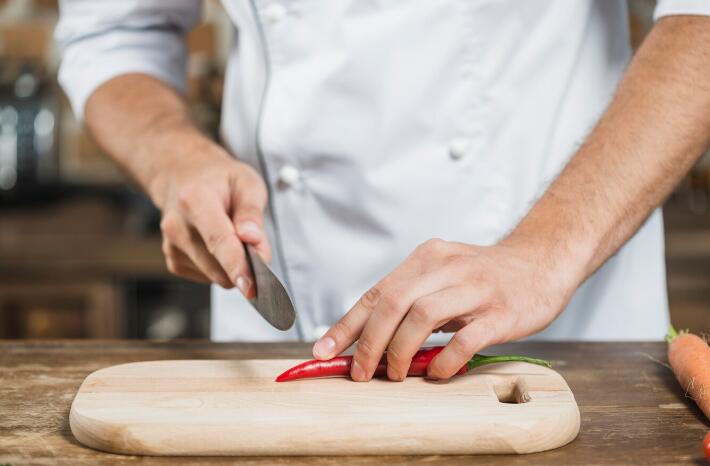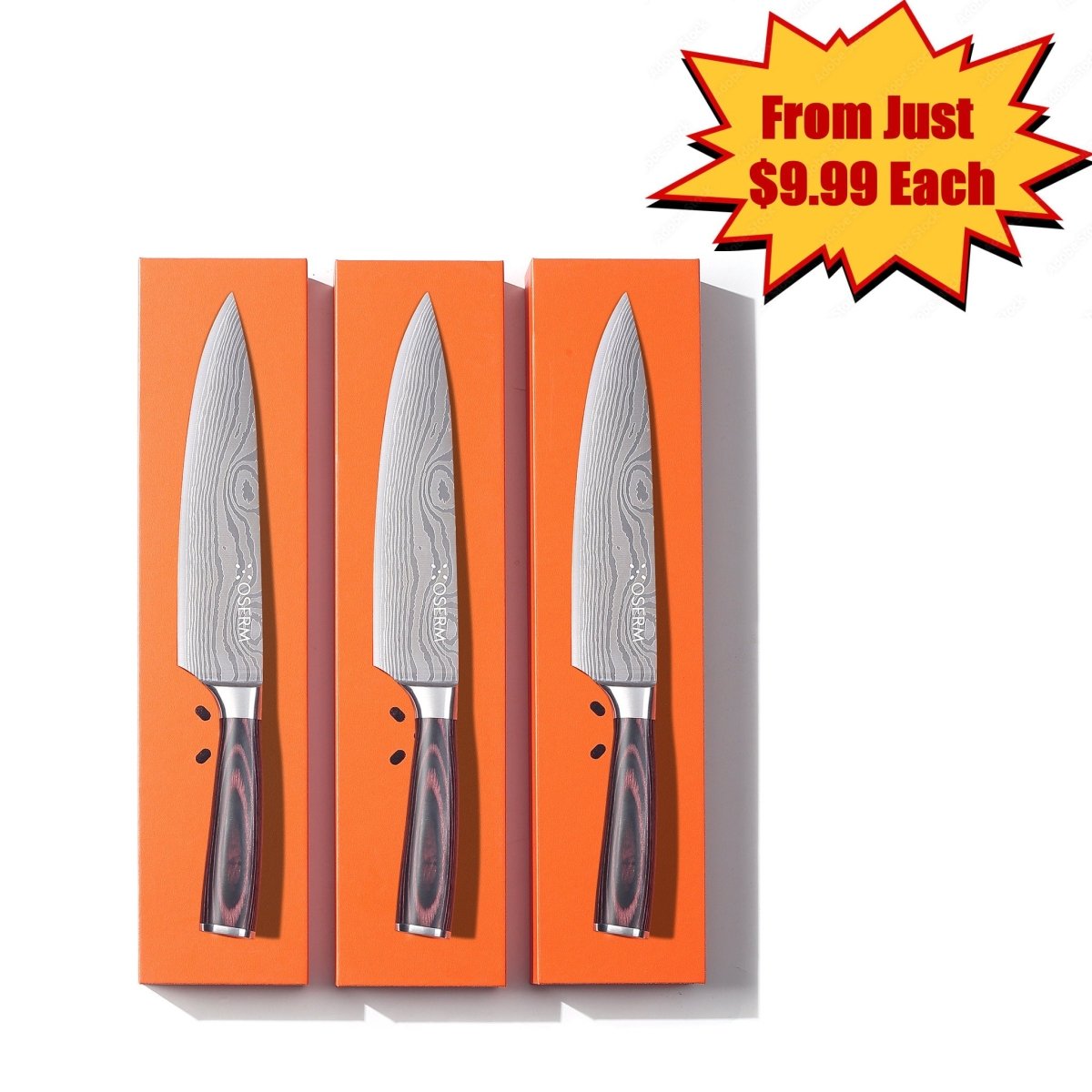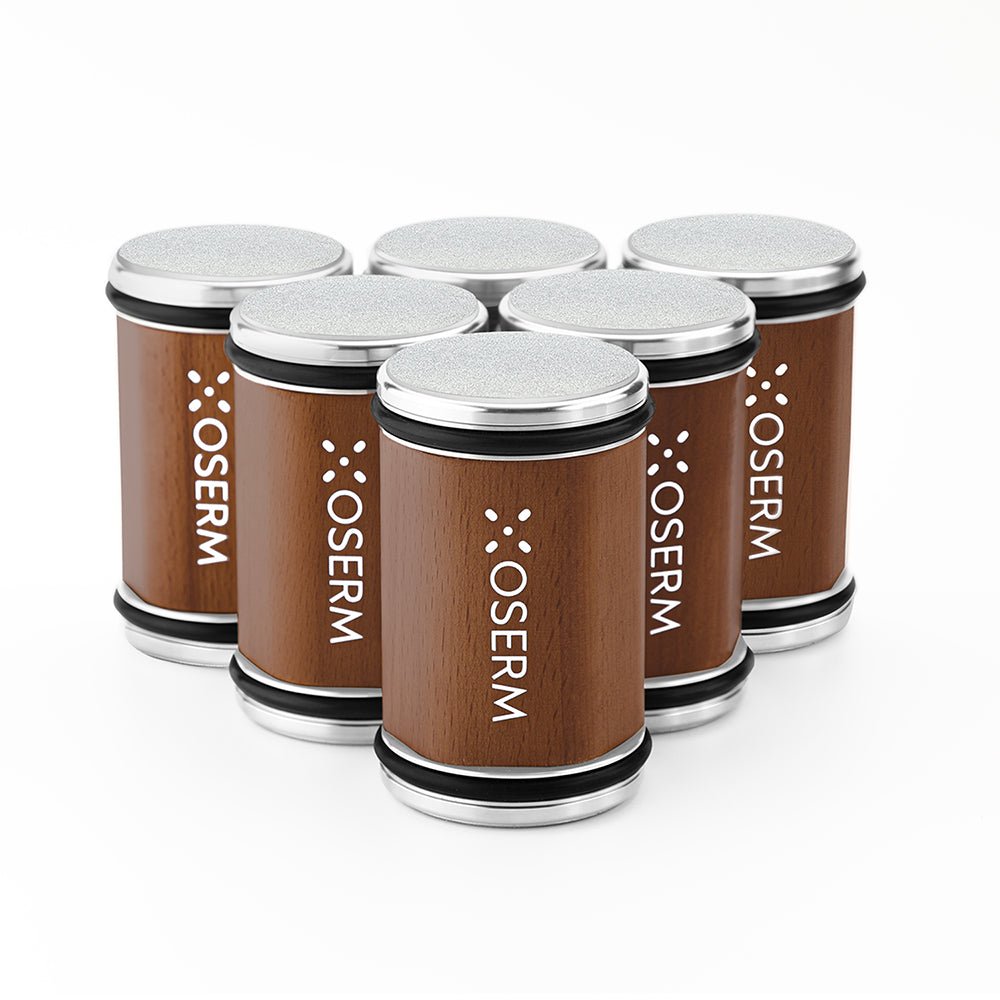
Choosing the Best Knife Sharpener: Comparing Whetstones, Honing Rods, Electric & Rolling Sharpeners
Maintaining a sharp knife is essential for safety and effectiveness in the kitchen. There are several tools available for sharpening knives, each with its own set of advantages and ideal uses. In this blog, we'll explore four popular types of knife sharpeners: whetstones, honing rods, electric sharpeners, and rolling knife sharpeners.
Whetstones
Whetstones, also known as sharpening stones, have been essential tools for blade maintenance for thousands of years. These stones are used for grinding and honing the edges of steel tools and implements, such as knives, scissors, and other blades.
Materials Used: Traditional whetstones can be made from a variety of natural materials, including quarried rock such as novaculite, sandstone, or other grained stones that possess suitable abrasive qualities. Man-made materials, including ceramics and bonded abrasives, are also common. These stones vary in grit size, which is measured by the granularity of the particles within the stone; finer grits are used for honing, while coarser grits reshape the edge.
Usage and Applications: Whetstones are used in various settings, from kitchens to workshops and industrial environments, reflecting their versatility. They come in several forms:
- Bench Stones: Typically used in a fixed location, like a workshop table, for regular tool maintenance.
- Pocket Stones: Smaller, portable versions for field use, handy for hunters or campers needing to sharpen tools on the go.
Historical Development: The use of whetstones dates back to prehistoric times when early humans discovered that certain types of stone could sharpen bone and later metal tools. Over the centuries, as metalworking became more sophisticated, the materials and techniques for making whetstones also evolved. In many cultures, particularly in places like Japan, the development of whetstones paralleled the craftsmanship of swords and culinary blades, becoming an integral part of cultural heritage.
In modern times, the variety of materials available for the manufacturing of whetstones has expanded, leading to innovations in durability and sharpening capabilities. Nonetheless, even with the advent of more modern sharpening technologies, the fundamental process of using a stone to sharpen a blade has remained relatively unchanged, underscoring the enduring effectiveness of this simple yet essential tool.
Whetstones remain popular even today due to their effectiveness and the level of control they offer, allowing for a precision edge that is often preferred by chefs and craftspeople who value the quality of a manually honed blade.
Honing Rods
Material Composition: Sharpening steels, commonly referred to as honing steels or rods, are traditionally made from hard materials such as carbon steel, ceramic, or diamond-coated steel. Each type offers different levels of abrasiveness, with diamond-coated steels providing the most aggressive honing and ceramic steels offering a gentler touch suitable for fine edge refinement.
Usage and Application: Sharpening rods are primarily used for honing knife blades, which involves realigning the edge of the knife to maintain its sharpness. They are not designed to grind away metal or create a new edge; rather, they enhance the existing edge's sharpness by straightening the microscopic teeth formed on the blade during cutting. This maintenance tool is a staple in both professional kitchens and home settings, ideal for chefs who regularly use their knives and need to maintain optimal performance.
Usage Scenarios:
- Professional Kitchens: Chefs use sharpening rods frequently to quickly realign knife edges between tasks, ensuring precision cuts.
- Home Kitchens: Home cooks benefit from using a sharpening rod to maintain knives for everyday tasks like chopping vegetables or slicing meat.
- Butcheries and Fishmongeries: Professionals in these industries often use honing steels to maintain the sharpness of their larger, more frequently used knives.
Historical Development: The concept of honing steel goes back centuries, with the basic need to maintain a sharp edge being as old as the tools themselves. Initially, any hard, smooth materials available, such as stones or even other metal tools, were used to hone blades. The development of dedicated honing steels began as metallurgy advanced, with early versions appearing in Europe as blacksmithing developed into a refined craft.
In the 19th century, as culinary arts and butchering became more sophisticated, the demand for professional-grade maintenance tools grew, leading to the standardization of honing steels. These tools became a symbol of a well-equipped kitchen, reflecting the skills and preparedness of the chef.
Modern Advancements: Today, sharpening steels have evolved in terms of material and design to accommodate the needs of modern blades, which are often made from very hard steels that require regular maintenance. Innovations such as oval-shaped rods or those with built-in guides help users maintain the correct angle for optimal honing.
Sharpening rods remain integral to knife care, offering a quick, effective way to maintain a blade's edge between more thorough sharpenings, thereby extending the life and effectiveness of kitchen knives.
Electric Sharpeners
Electric knife sharpeners are designed to offer a quick, efficient, and often foolproof method for sharpening kitchen knives, making them a favored tool in both domestic and professional settings. Here’s a closer look at their construction, usage, and development history:
Materials and Construction:
Electric knife sharpeners usually consist of one or more slots equipped with abrasive wheels that spin when powered. These wheels are often made from materials such as ceramic, diamond abrasives, or tungsten carbide, which provide durability and a fine, sharp edge on the blades. The sharpener's body is typically constructed from plastic or metal, ensuring longevity and sturdiness during use.
Usage:
Designed for ease of use, electric sharpeners require the user to pull the knife through the slots. Each slot is designed to provide a different stage of sharpening—from coarse grinding to fine honing. This setup helps in restoring and refining the edges of the knives. The automated movement of the abrasive wheels ensures that even those without any sharpening skills can achieve a consistent edge with minimal effort.
Development and Evolution:
The development of electric knife sharpeners is part of the broader trend towards kitchen automation and efficiency. Initially, knife sharpening required manual tools and significant skill, and was time-consuming. The introduction of electric sharpeners has democratized knife sharpening, making it accessible and manageable for everyone. Over the years, these devices have seen various innovations, such as the inclusion of multiple sharpening stages and improvements in the quality of abrasives used, enhancing their effectiveness and the fineness of the edge they can produce.
Ideal Usage Scenario:
Electric knife sharpeners are ideal for those who need a quick and reliable method to keep their knives in top condition without the hassle of manual sharpening. They are particularly valued in professional kitchens where time is of the essence and in households where culinary activities are frequent.
These sharpeners have revolutionized how we maintain our cutting tools, making them a staple in modern kitchens for anyone looking to maintain their knives with ease and precision.
Rolling Knife Sharpeners
The Rolling Knife Sharpener represents a contemporary approach to knife maintenance, combining convenience and precision to cater to modern kitchen needs. This sharpener typically incorporates a handheld device with a rolling mechanism that utilizes abrasive materials to hone and sharpen knife blades. Here’s a deeper look into the construction and application of rolling knife sharpeners:
Materials and Construction:
Rolling knife sharpeners often feature diamond grinding discs or wheels. These abrasives are chosen for their durability and effectiveness in sharpening hardened steel blades. The sharpener might include different grit sizes for both coarse sharpening and fine honing, ensuring that knives can be restored from dull to razor-sharp with relative ease.
Usage:
These devices are designed for simplicity, requiring minimal skill from the user. By setting the knife at the correct angle against the sharpener, the user rolls the device along the blade's edge, effectively sharpening the knife without the need for traditional whetstone techniques. This method is particularly valued for its ability to maintain a consistent angle, a critical factor in achieving a sharp edge.
Development and Evolution:
The concept of rolling sharpeners has evolved as part of the broader trend towards making kitchen tasks more efficient and less skill-dependent. Historical sharpening methods often required significant manual skill and a deep understanding of blade geometry. Modern rolling sharpeners simplify the process, making it accessible to a wider audience without compromising on the quality of sharpening.
Ideal Usage Scenario:
Rolling knife sharpeners are best suited for home cooks who require frequent sharpening due to regular use of knives but do not have the time or desire to engage with more labor-intensive methods. They are also beneficial in professional settings where time efficiency is crucial.
This type of sharpener has become a popular choice for those seeking a practical, straightforward solution to knife maintenance, reflecting a shift in consumer preferences towards gadgets that offer time savings and convenience without sacrificing performance
Here’s a comparative overview of the different knife sharpening tools: whetstones, honing rods, electric knife sharpeners, and rolling knife sharpeners. Each has its own set of strengths and weaknesses and caters to different user needs and skill levels:
Whetstones:
- Advantages: Offers meticulous control over the sharpening process, allowing for a customized edge based on the angle and pressure applied. It's the preferred choice for culinary professionals and enthusiasts who value precision.
- Disadvantages: Requires skill and practice to use effectively. The process is time-consuming and may not be ideal for those looking for quick results.
- Ideal for: Chefs and culinary enthusiasts who appreciate and have the time for the art of sharpening. Suitable for maintaining high-quality knives and achieving a razor-sharp edge.
Honing Rods:
- Advantages: Not primarily for sharpening but for realigning the knife’s edge between sharpenings, which extends the blade's sharpness and life. Quick and easy to use.
- Disadvantages: Does not actually sharpen dull blades but rather straightens the existing edge.
- Ideal for: Regular knife users to maintain edge sharpness after every few uses, particularly useful in professional kitchens.
Electric Knife Sharpeners:
- Advantages: Provides quick and consistent results with minimal effort. Often features multiple sharpening stages for different levels of sharpness.
- Disadvantages: Can remove more material from the knife than necessary if used improperly. Less control over the sharpening process compared to manual methods.
- Ideal for: Busy individuals or kitchens that need to maintain a large set of knives efficiently without requiring specialized sharpening skills.
Rolling Knife Sharpeners:
- Advantages: Easy to use with more control than electric sharpeners but less skill required than for whetstones. Portable and usually quicker than using a whetstone.
- Disadvantages: May not provide the same level of precision as whetstones and can be less durable than other sharpeners.
- Ideal for: Home users who want a balance between ease of use and control over the sharpening process, suitable for those who may not have the time or desire to learn traditional sharpening techniques.
Comparison Chart:
| Sharpener Type | Pros | Cons | Ideal for |
|---|---|---|---|
| Whetstones | High precision and control | Requires skill and time | Professionals & enthusiasts |
| Honing Rods | Quick maintenance | Does not sharpen dull blades | Regular upkeep between uses |
| Electric | Fast and easy to use | Less control, can remove more metal | Busy kitchens, non-experts |
| Rolling | Easy to use, portable | Less durable, varying effectiveness | Home cooks, frequent knife users |
Conclusion:
Choosing the right sharpening tool depends on the user's skill level, the types of knives they own, and their specific needs. Whetstones offer the highest level of precision and customization but require the most skill and time. Honing rods are great for maintenance between sharpenings, while electric sharpeners and rolling sharpeners provide more convenient and faster alternatives with varying degrees of control and effectiveness. Each tool has a place depending on the situation and the user’s requirements.
Choosing the right knife sharpener depends on your needs, the types of knives you use, and how much time you are willing to dedicate to knife maintenance. Each type of sharpener has its place in the kitchen, and the best choice varies from one cook to another.
Our Suggestion:
If you're like many of our customers—not a professional chef but someone who enjoys cooking and loves life—you probably don't want to spend too much time sharpening knives. It’s a necessary task, but it shouldn’t take away from your cooking and enjoyment. We highly recommend trying our OSERM Rolling Knife Sharpener. It’s designed to significantly reduce the time you spend sharpening, so you can focus more on cooking, savoring your meals, and enjoying life to the fullest!
We understand that for anyone who loves to cook, a sharp knife is essential. It doesn’t matter how often you use it; a knife must be sharp to be effective. While some high-end knives made from specialized steel can stay sharp longer, they eventually need to be sharpened too, and they can be costly and challenging to maintain due to their hardness. That’s where our OSERM Rolling Knife Sharpener comes into play, offering a practical solution without the steep learning curve or time investment.
One More Solution in Your Kitchen:
Based on our understanding of these common pain points, we thought: why not keep our customers supplied with sharp knives without any hassle? That’s why we developed the OSERM's "Always Sharp" Chef Knife Subscription Plan. This plan ensures you always have the sharpest blades, right when you need them, without any fuss over sharpening.
Why Choose "Always Sharp"?
Our "Always Sharp" plan isn't just about providing knives; it's about delivering a seamless cooking experience. Here’s what it offers:
- Save Time & Money: Get the sharpest knives without ever needing to sharpen them yourself. Say goodbye to the hassle and hello to precision cutting. Plus, enjoy free shipping directly to your doorstep.
- Flexible Plans to Suit Your Needs: Whether you cook daily or occasionally, we have a plan that fits your lifestyle. Choose from monthly, quarterly, biannual, or annual subscriptions to keep your blades perfect for every meal.
Join the "Always Sharp" Revolution
Upgrade to ease and excellence in your kitchen with OSERM's "Always Sharp" Chef Knife Subscription Plan. Forget the frustration of dull knives and the time wasted in sharpening. Embrace the convenience of having top-quality, sharp knives at all times.
Ready to transform your kitchen experience? Click here to learn more about the "Always Sharp" Chef Knife Subscription Plan and join the community that values quality and convenience in their culinary pursuits.






